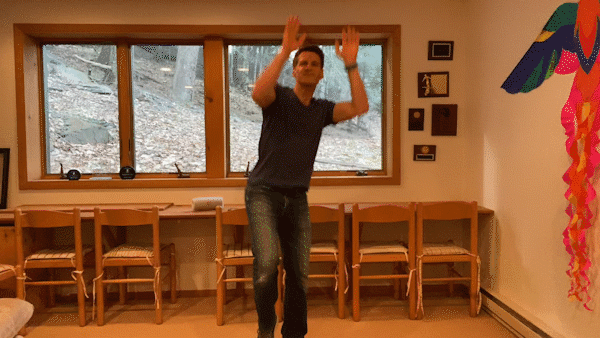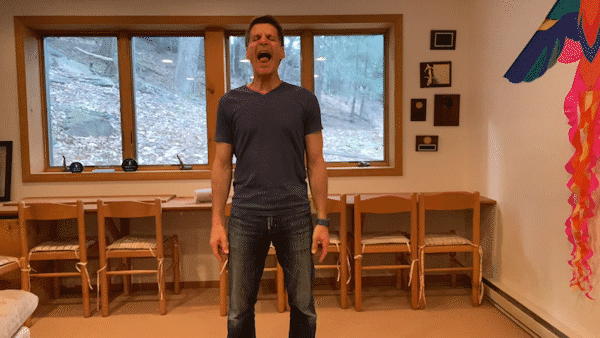Missed Part I? Read it here.
Do you know the Serenity Prayer? “God, grant me the serenity to accept the things I cannot change, courage to change the things I can, and wisdom to know the difference.” It was written by the theologian Reinhold Niebuhr during the Great Depression, and then invoked again by him in a sermon in 1943, in the middle of World War II.
It’s time to hear it again.
But we need more than an inspirational philosophy. We need a path.
So how do we get good at accepting the things we cannot change? There are two main challenges. One is becoming more skilled – more comfortable and practiced – at letting go of control, and the other is releasing the stress – in our minds and our bodies – of living in uncertainty.
I’ve been experimenting with some concrete, practical ways to do both. I’d like to offer you four practices – things you can do – that will help you endure the physical, intellectual, emotional, and spiritual challenges of living and leading in uncertainty.
They are super simple and require no skill. You can do one of them or all of them. You can do them when you think you need it or every day to reduce stress and develop your confidence, strength, and resilience. They are tools in your toolbox. They will help you be a stronger person and a more grounded, capable leader in the reality of uncertainty.
I have recorded myself doing each one to make it easier for you to take the risk of doing it. I say risk because, while there is, literally, zero risk in doing any of these, some of them may feel risky since you may judge yourself or worry about what others think of you when you do them. That’s actually part of why they work. You are letting go of control, including how you imagine others may think of you (or how you think of yourself).
That is part of what it means to have the freedom to act. If I can do them here for all of you to see, you can do them by yourself, in private.
Here are the four practices:
1. Meditation
As the meditation teacher Tara Brach said recently: “This is what we’ve been training for.” There are lots of ways to meditate; I will share a very simple practice.

Decide how long you want to meditate, sit comfortably with your back supported and your neck free, and focus on your breath going in and out of your nose. Inevitably, your thoughts will wander off your breath to any number of things. That’s part of the point. You can’t control thinking. It’s what your mind naturally does. When you notice your thoughts, without fanfare or judgement, just bring your focus back to your breath. Also inevitably, you will have the urge to do something – stop meditating, write something down that occurred to you, or simply follow a thought. When that happens, notice it and bring your attention back to your breath.
Sit for the time you committed. I meditate for 20 minutes twice a day. Let go of control.
2. Dance.
This one is simple, even if you’re one of those people who says, “Sorry, I don’t dance!” You can do it.

Just put on music, loud enough that it feels inspiring or maybe just drowns out your inhibitions, and let your body move to the beat. That’s it.
As the poet Mary Oliver wrote in her poem Wild Geese: “You only have to let the soft animal of your body love what it loves.” In this case, it might be about your body, but it’s not about you. We do this in all our leadership programs and it’s one of the things that, years later, people tell me they continue to do and it continues to have an impact on them. Try it for a song or two.
3. Shaking.
Stand with your feet firmly on the ground, knees bent, body relaxed, arms at your side, and start bouncing from your knees. Feet don’t leave the ground. Let that bouncing start to rise up through your body and share your whole body. Breathe and shake. Keep going for longer than you think. If you feel uncomfortable, all the better. Let go of the need to control anything – what you look like, the shaking, anything. Let go. Use your voice to let out any sounds that might be there while your body relaxes. I do this for about 8 minutes.

My advice is to do it a little longer than is comfortable. Not only will that help you rid yourself of stress, but it will build your resilience in the face of stress.
4. Gibberish.

This is an acting tool and also used in certain therapies. It’s talking (of sorts), without using words. Just start blabbering, using nonsensical words with lots of emotion. Let your body get into it. Flail and punch and stomp and wiggle. Be loud, angry, funny, sad, passionate. Be open to letting go of control and letting whatever comes out, come out. Surprise yourself. I do this for 5 minutes or so.
These practices are physical. Stress and control live in your body as much as they live in your mind, maybe more so. You can’t think your way out of stress and letting go. You may (probably will) feel awkward or silly doing these. That’s your control too. Which means that simply doing them is an act of letting go and will impact your resilience.
Immediately after doing any of these, pause for a few moments to feel the impact on your body, your mind, your emotions, even your soul. Feel the difference from before and after.
You will feel the difference. I know that I do.
I feel like I can breathe again and that no matter what else I do in the day, I probably won’t look or feel as silly as I did doing these things, and I notice that I have let go a little more.
And if I have any lingering sense of my own importance, it is quickly quashed by my spiritual teacher and 12-year-old son Daniel, who bursts out laughing every time he looks at my new haircut.

Especially. The dancing is great for being in the present. Thanks Peter
Thanks Peter. Your videos made me giggle and that in and of itself is a great way to start the day. We all need a dose of reality to keep it real. I will be giving these tools a try.
yes!! Giggling is also letting go of control :-)!
Peter, thanks for having the courage to let go of the need to feel in control and for showing us the way!
My inner control freak has a few questions for you:
1) Is it OK to meditate with bad breath?
2) I have no rhythm. May I still dance?
3) Is it OK to rattle and roll while I shake?
4) Where can I find a gibberish dictionary in French?
Just kidding! :-)
Bon week-end to you and your family.
Oui. Oui. Oui. Et oui!!
I love these! I’m especially grateful for the videos, not only because they demonstrate the technique but are also a great example of emotional courage and vulnerability. I’m familiar with 1 & 2, but less with 3 & 4 and would love to try them out. I’m very curious to learn more about how these and other somatic practices work and how to weave them into my routine. Thank you!
Amor fati